stop start PEUGEOT BIPPER 2010 Owner's Manual
[x] Cancel search | Manufacturer: PEUGEOT, Model Year: 2010, Model line: BIPPER, Model: PEUGEOT BIPPER 2010Pages: 166, PDF Size: 4.22 MB
Page 63 of 166
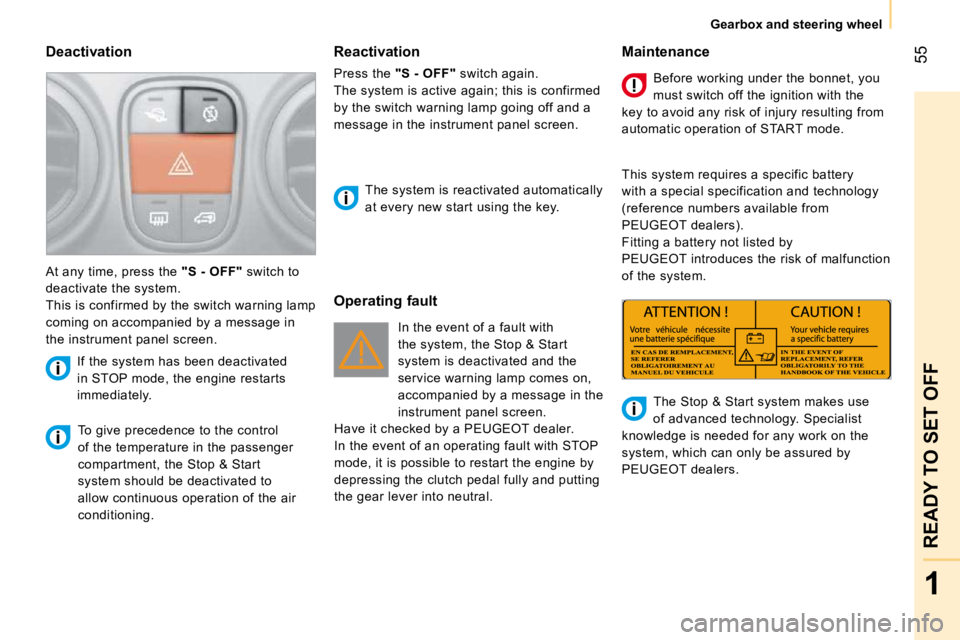
55
1
READY TO SET OFF
Gearbox and steering wheel
Deactivation
To give precedence to the control
of the temperature in the passenger
compartment, the Stop & Start
system should be deactivated to
allow continuous operation of the air
conditioning. The system is reactivated automatically
at every new start using the key.
At any time, press the "S - OFF" switch to
deactivate the system.
This is confirmed by the switch warning lamp
coming on accompanied by a message in
the instrument panel screen.
If the system has been deactivated
in STOP mode, the engine restarts
immediately. Operating fault Maintenance
In the event of a fault with
the system, the Stop & Start
system is deactivated and the
service warning lamp comes on,
accompanied by a message in the
instrument panel screen.
Have it checked by a PEUGEOT dealer.
In the event of an operating fault with STOP
mode, it is possible to restart the engine by
depressing the clutch pedal fully and putting
the gear lever into neutral. Before working under the bonnet, you
must switch off the ignition with the
key to avoid any risk of injury resulting from
automatic operation of START mode.
This system requires a specific battery
with a special specification and technology
(reference numbers available from
PEUGEOT dealers).
Fitting a battery not listed by
PEUGEOT introduces the risk of malfunction
of the system.
The Stop & Start system makes use
of advanced technology. Specialist
knowledge is needed for any work on the
system, which can only be assured by
PEUGEOT dealers.
Reactivation
Press the
"S - OFF" switch again.
The system is active again; this is confirmed
by the switch warning lamp going off and a
message in the instrument panel screen.
Page 93 of 166

4
EASE OF USE and COMFORT
Ventilation
DE-ICING AND DEMISTING
Windscreen
The ventilation outlets located at the base
of the windscreen and the side vents for the
side windows increase the effectiveness of
the de-icing and demisting. Do not obstruct
these eight air outlets.
The manual air conditioning consists of the
pollen filter and air recirculation.
The pollen filter permits continuous and
effective filtering of dust.
The air recirculation (which can be activated
by the driver or the passenger) isolates the
passenger compartment from the exterior
atmosphere. However, this position should
only be used temporarily, the norm is to
drive with the control positioned with the
exterior air intake open. Manual mode
Direct the control to this air
distribution setting.
For faster and more effective
de-icing and demisting of the
windscreen: - increase the air flow setting,
Returning to the exterior air
intake position permits renewal
of the air in the passenger
compartment. Rear screen and mirrors de-icing
This function only operates when
the engine is running. Pressing
this button activates the rapid
demisting/de-icing of the rear
screen and mirrors. This function switches
off automatically to prevent an excessive
consumption of energy. It switches off when
the engine is switched off. Pressing this
button switches the function off.
- move the exterior air intake
control temporarily to air
recirculation.
With Stop & Start, when the heated
rear screen is switched on, the STOP
mode is not available.
Page 107 of 166

98
Driving safely
Emergency braking assistance *
System which, in an emergency, enables
you to reach the optimum braking pressure
more quickly, thus reducing the stopping
distance. The emergency braking assistance
is an integral part of the ESP system.
Activation
It is brought into play by the speed at which
the brake pedal is pressed.
The effect of this is a reduction in the
resistance of the pedal and an increase in
braking efficiency.
When braking in an emergency, press firmly
without releasing the pressure.
Good practice
This system cannot be deactivated by the
driver.
* Depending on country of sale.
TRAJECTORY CONTROL SYSTEMS
Electronic stability programme (ESP)
The electronic stability programme acts on
the brake of one or more wheels and on the
engine to keep the vehicle on the trajectory
required by the driver, within the limits of the
laws of physics.
Activation
The ESP system is activated automatically
each time the vehicle is started and cannot
be deactivated.
It comes into operation in the event of a grip
or trajectory problem.
Illumination of this warning lamp
and the warning lamp in the
"ASR OFF" button, accompanied
by a message in the instrument
panel screen, indicates a fault with the ESP
system, which is deactivated automatically.
Have it checked by a PEUGEOT dealer. Anti-slip regulation (ASR) and engine
control (MSR)
Anti-slip regulation (also known as traction
control) optimises traction, avoiding wheel
spin by acting on the brakes of the driving
wheels and the engine.
Engine control is an integral part of the ASR
system and intervenes when a sudden gear
change is made or of one of the driving
wheels looses grip, by reducing engine
torque to avoid loss of stability of the vehicle.
Activation
These systems are activated automatically
every time the vehicle is started.
In the event of a problem od adhesion or
trajectory, these systems come into play.
Deactivation
In exceptional conditions (starting a vehicle
which is bogged down, stuck in snow,
on soft ground...), it may be advisable to
deactivate the ASR system, so that the
wheels can spin freely and regain grip.
� Press the "ASR OFF" button, located in
the middle of the dashboard.
If the button's warning lamp comes
on, accompained by a message in the
instrument panel screen, this indicates that
the ASR system is deactivated.
This is indicated by flashing of this
warning lamp in the instrument
panel.
Operating fault
Page 108 of 166

98
Driving safely
Emergency braking assistance *
System which, in an emergency, enables
you to reach the optimum braking pressure
more quickly, thus reducing the stopping
distance. The emergency braking assistance
is an integral part of the ESP system.
Activation
It is brought into play by the speed at which
the brake pedal is pressed.
The effect of this is a reduction in the
resistance of the pedal and an increase in
braking efficiency.
When braking in an emergency, press firmly
without releasing the pressure.
Good practice
This system cannot be deactivated by the
driver.
* Depending on country of sale.
TRAJECTORY CONTROL SYSTEMS
Electronic stability programme (ESP)
The electronic stability programme acts on
the brake of one or more wheels and on the
engine to keep the vehicle on the trajectory
required by the driver, within the limits of the
laws of physics.
Activation
The ESP system is activated automatically
each time the vehicle is started and cannot
be deactivated.
It comes into operation in the event of a grip
or trajectory problem.
Illumination of this warning lamp
and the warning lamp in the
"ASR OFF" button, accompanied
by a message in the instrument
panel screen, indicates a fault with the ESP
system, which is deactivated automatically.
Have it checked by a PEUGEOT dealer. Anti-slip regulation (ASR) and engine
control (MSR)
Anti-slip regulation (also known as traction
control) optimises traction, avoiding wheel
spin by acting on the brakes of the driving
wheels and the engine.
Engine control is an integral part of the ASR
system and intervenes when a sudden gear
change is made or of one of the driving
wheels looses grip, by reducing engine
torque to avoid loss of stability of the vehicle.
Activation
These systems are activated automatically
every time the vehicle is started.
In the event of a problem od adhesion or
trajectory, these systems come into play.
Deactivation
In exceptional conditions (starting a vehicle
which is bogged down, stuck in snow,
on soft ground...), it may be advisable to
deactivate the ASR system, so that the
wheels can spin freely and regain grip.
� Press the "ASR OFF" button, located in
the middle of the dashboard.
If the button's warning lamp comes
on, accompained by a message in the
instrument panel screen, this indicates that
the ASR system is deactivated.
This is indicated by flashing of this
warning lamp in the instrument
panel.
Operating fault
Page 111 of 166
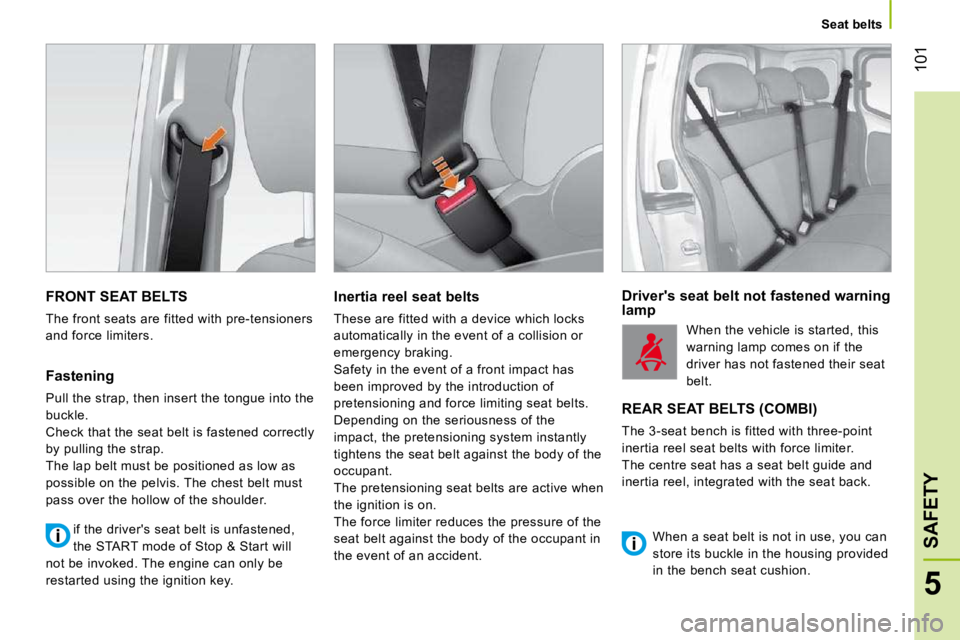
101
5
SAFETY
Seat belts
FRONT SEAT BELTS
The front seats are fitted with pre-tensioners
and force limiters.
Fastening
Pull the strap, then insert the tongue into the
buckle.
Check that the seat belt is fastened correctly
by pulling the strap.
The lap belt must be positioned as low as
possible on the pelvis. The chest belt must
pass over the hollow of the shoulder. Inertia reel seat belts
These are fitted with a device which locks
automatically in the event of a collision or
emergency braking.
Safety in the event of a front impact has
been improved by the introduction of
pretensioning and force limiting seat belts.
Depending on the seriousness of the
impact, the pretensioning system instantly
tightens the seat belt against the body of the
occupant.
The pretensioning seat belts are active when
the ignition is on.
The force limiter reduces the pressure of the
seat belt against the body of the occupant in
the event of an accident. Driver's seat belt not fastened warning
lamp
When the vehicle is started, this
warning lamp comes on if the
driver has not fastened their seat
belt.
REAR SEAT BELTS (COMBI)
The 3-seat bench is fitted with three-point
inertia reel seat belts with force limiter.
The centre seat has a seat belt guide and
inertia reel, integrated with the seat back.
When a seat belt is not in use, you can
store its buckle in the housing provided
in the bench seat cushion.
if the driver's seat belt is unfastened,
the START mode of Stop & Start will
not be invoked. The engine can only be
restarted using the ignition key.
Page 133 of 166
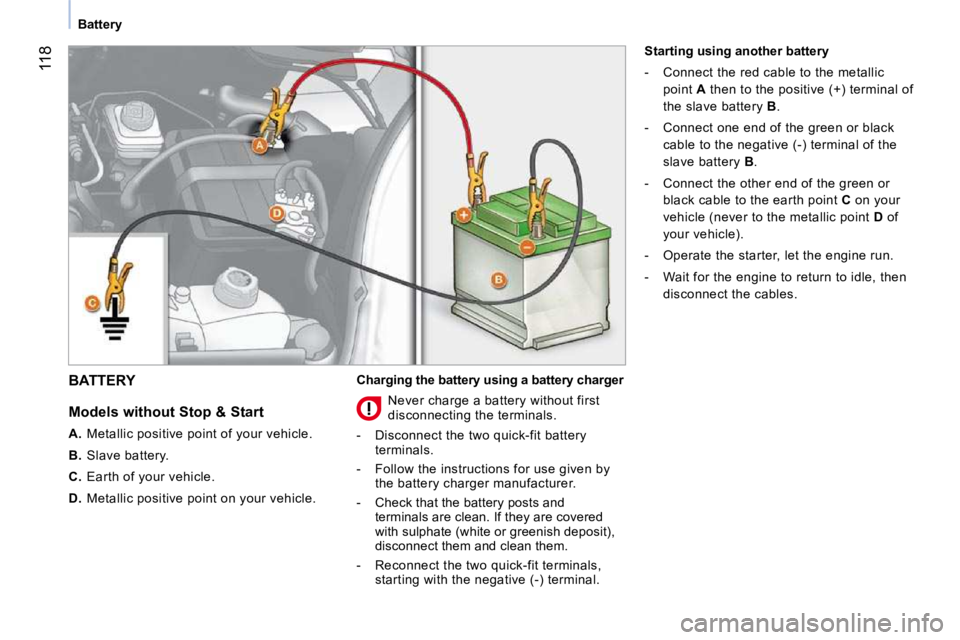
118
Battery
BATTERY
Models without Stop & Start
A. Metallic positive point of your vehicle.
B. Slave battery.
C. Earth of your vehicle.
D. Metallic positive point on your vehicle. Charging the battery using a battery charger Starting using another battery
- Connect the red cable to the metallic
point A then to the positive (+) terminal of
the slave battery B .
- Connect one end of the green or black cable to the negative (-) terminal of the
slave battery B .
- Connect the other end of the green or black cable to the earth point C on your
vehicle (never to the metallic point D of
your vehicle).
- Operate the starter, let the engine run.
- Wait for the engine to return to idle, then disconnect the cables.
Never charge a battery without first
disconnecting the terminals.
- Disconnect the two quick-fit battery terminals.
- Follow the instructions for use given by the battery charger manufacturer.
- Check that the battery posts and terminals are clean. If they are covered
with sulphate (white or greenish deposit),
disconnect them and clean them.
- Reconnect the two quick-fit terminals, starting with the negative (-) terminal.
Page 134 of 166

119
7
QUICK HELP
Battery
Models with Stop & Start
A. Protective cover.
B. Positive metallic point on your vehicle.
C. Slave battery.
D. Earth on your vehicle.
E. Terminal release button.
F. Check sensor button.
G. State of charge sensor.
H. Metal negative point of your vehicle. Charging the battery using a battery charger - Follow the instructions for use given by
the battery charger manufacturer.
- Check that the battery posts and terminals are clean. If they are covered
with sulphate (white or greenish deposit),
disconnect them and clean them.
- Reconnect connector F of the check
sensor G .
- Refit the protective cover A to the
metallic point B .
Starting using another battery
- Remove the protective cover A from the
metallic point B .
- Connect the red cable to metallic point B ,
then the (+) terminal to the slave battery C .
- Connect one end of the green or black cable to the (-) terminal of the slave
battery C .
- Connect the other end of the green or black cable to the earth point D of your
vehicle (never to the metallic point H of
your vehicle).
- Operate the starter, let the engine run.
- Wait for the engine to return to idle, then disconnect the cables.
- Refit the protective cover A to the
metallic point B .
The Stop & Start battery does not have
to be disconnected for charging.
- Press the release button E to disconnect
the terminal F .
- Disconnect the connector F of the check
sensor G .
- Remove the protective cover A from the
metallic point B .
- Connect the charger cables: (+) on the metallic point B ; (-) on the metallic point H . Never remove the check sensor
G
from the metallic point H , except
when replacing the battery.
Page 135 of 166

120
Battery Batteries contain harmful substances
such as sulphuric acid and lead. They
must be disposed of in accordance with the
law and must not, in any circumstances be
discarded with household waste.
Take used batteries to an authorised waste
disposal site.
It is advisable to disconnect the battery
if the vehicle is not to be used for a
period of more than one month. To do
this on models with Stop & Start:
- press the release button E to disconnect
connector F ,
- disconnect connector F of check sensor G .
Never remove the check sensor G from the
metallic point H , except when replacing the
battery.
The presence of this label, in particular
with the Stop & Start system, indicates
the use of a 12 V lead-acid battery with
special technology and specification, for
which the involvement of a PEUGEOT
dealer is required when replacing or
disconnecting the battery.
Failure to observe this recommendation may
cause premature wear of the battery.
After refitting the battery, the Stop &
Start system will only be active after
a continuous period of immobilisation of
the vehicle, a period which depends on the
climatic conditions and the state of charge of
the battery (up to about 8 hours). Before charging
The charging operation must be carried
out in a ventilated area away from naked
flames or any possible sources of sparks to
eliminate the risks of explosion and fire.
Do not attempt to charge a frozen battery: it
must first be thawed to eliminate the risks of
explosion. If the battery has frozen, before
charging it have it checked by a specialist
who will check that the internal components
have not been damaged and that the
container is not cracked, which could mean
that there is a risk of a leak of toxic and
corrosive acid.
Before disconnecting
Never disconnect a terminal when the
engine is running.
Before disconnecting the battery, you must wait
for 2 minutes after switching off the ignition.
Close the windows and doors before
disconnecting the battery. After reconnecting
After every reconnection of the battery,
switch on the ignition and wait 1 minute
before starting to allow the electronic
systems to be initialised. If difficulties are
experienced after this, contact a PEUGEOT
dealer.
If the battery has been disconnected
for some time, it may be necessary to
reinitialise the following functions:
- the display parameters (date, time,
language, distance and temperature
units),
- the radio stations,
- the central locking.
Some settings are cleared and must be
reprogrammed. Contact a PEUGEOT dealer.
Page 157 of 166
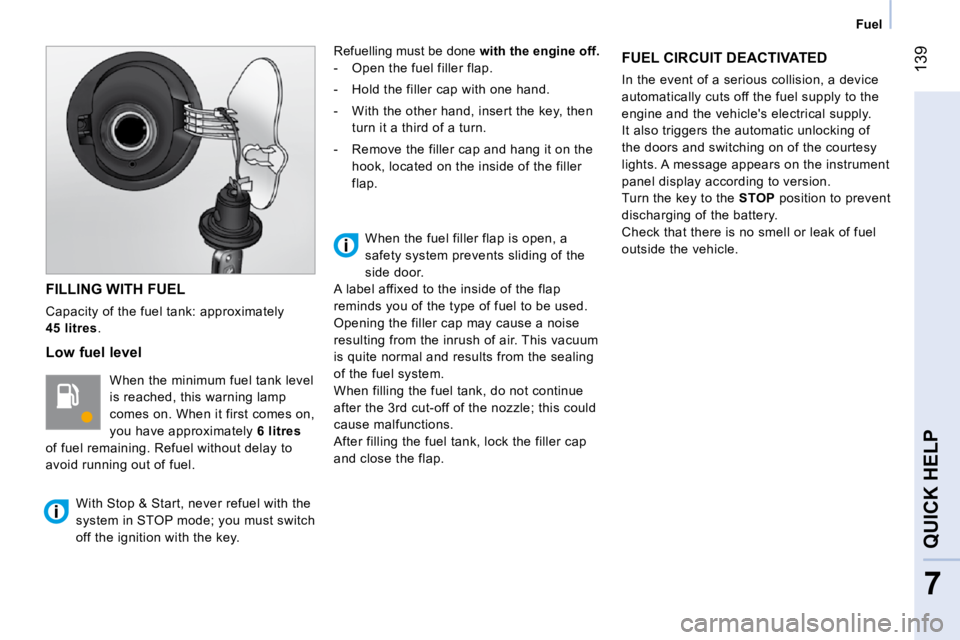
139
7
QUICK HELP
Fuel
FILLING WITH FUEL
Capacity of the fuel tank: approximately
45 litres .
Low fuel level
When the minimum fuel tank level
is reached, this warning lamp
comes on. When it first comes on,
you have approximately 6
litres
of fuel remaining. Refuel without delay to
avoid running out of fuel. Refuelling must be done
with the engine off.
- Open the fuel filler flap.
- Hold the filler cap with one hand.
- With the other hand, insert the key, then turn it a third of a turn.
- Remove the filler cap and hang it on the hook, located on the inside of the filler
flap.
FUEL CIRCUIT DEACTIVATED
In the event of a serious collision, a device
automatically cuts off the fuel supply to the
engine and the vehicle's electrical supply.
It also triggers the automatic unlocking of
the doors and switching on of the courtesy
lights. A message appears on the instrument
panel display according to version.
Turn the key to the STOP position to prevent
discharging of the battery.
Check that there is no smell or leak of fuel
outside the vehicle.
With Stop & Start, never refuel with the
system in STOP mode; you must switch
off the ignition with the key. When the fuel filler flap is open, a
safety system prevents sliding of the
side door.
A label affixed to the inside of the flap
reminds you of the type of fuel to be used.
Opening the filler cap may cause a noise
resulting from the inrush of air. This vacuum
is quite normal and results from the sealing
of the fuel system.
When filling the fuel tank, do not continue
after the 3rd cut-off of the nozzle; this could
cause malfunctions.
After filling the fuel tank, lock the filler cap
and close the flap.
Page 158 of 166
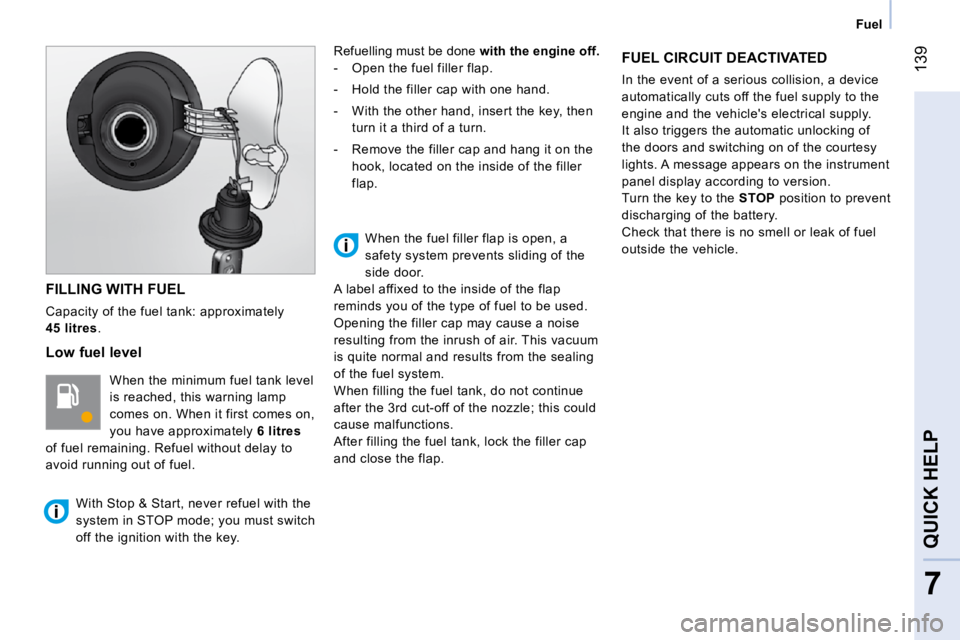
139
7
QUICK HELP
Fuel
FILLING WITH FUEL
Capacity of the fuel tank: approximately
45 litres .
Low fuel level
When the minimum fuel tank level
is reached, this warning lamp
comes on. When it first comes on,
you have approximately 6
litres
of fuel remaining. Refuel without delay to
avoid running out of fuel. Refuelling must be done
with the engine off.
- Open the fuel filler flap.
- Hold the filler cap with one hand.
- With the other hand, insert the key, then turn it a third of a turn.
- Remove the filler cap and hang it on the hook, located on the inside of the filler
flap.
FUEL CIRCUIT DEACTIVATED
In the event of a serious collision, a device
automatically cuts off the fuel supply to the
engine and the vehicle's electrical supply.
It also triggers the automatic unlocking of
the doors and switching on of the courtesy
lights. A message appears on the instrument
panel display according to version.
Turn the key to the STOP position to prevent
discharging of the battery.
Check that there is no smell or leak of fuel
outside the vehicle.
With Stop & Start, never refuel with the
system in STOP mode; you must switch
off the ignition with the key. When the fuel filler flap is open, a
safety system prevents sliding of the
side door.
A label affixed to the inside of the flap
reminds you of the type of fuel to be used.
Opening the filler cap may cause a noise
resulting from the inrush of air. This vacuum
is quite normal and results from the sealing
of the fuel system.
When filling the fuel tank, do not continue
after the 3rd cut-off of the nozzle; this could
cause malfunctions.
After filling the fuel tank, lock the filler cap
and close the flap.